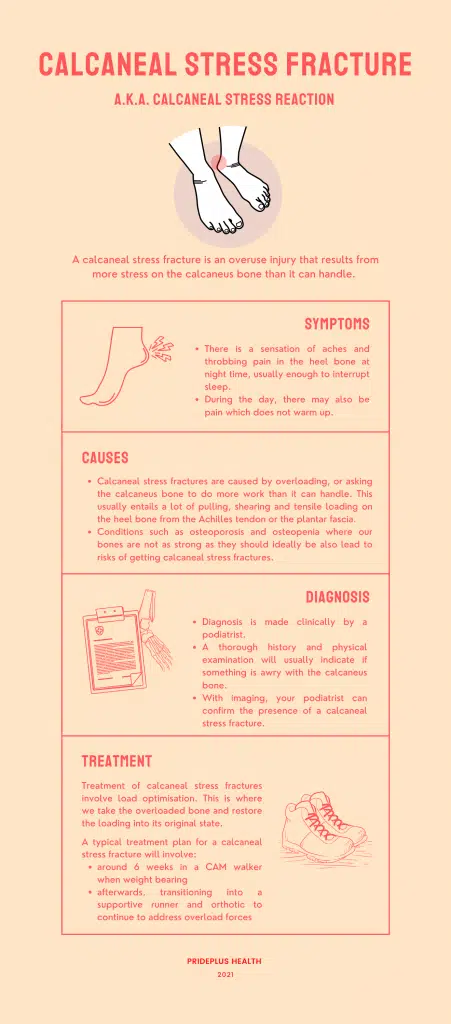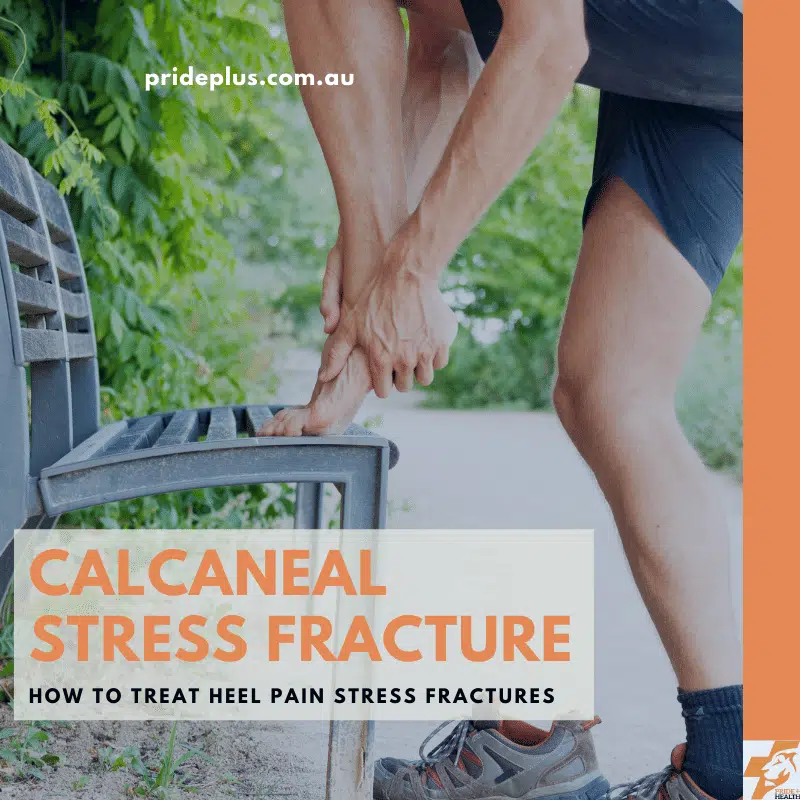While it’s hardly a daily occurrence for a calcaneal stress fracture to walk through this podiatrists door, they’re still common enough to cause plenty of people trouble.
What is a Calcaneal Stress Fracture
A calcaneal stress fracture is a relatively uncommon type of heel pain. The fact that it doesn’t happen as often as other types of heel pain like plantar fasciitis is no comfort to someone with a stress fracture.
The calcaneus bone is one of the hardest working in our body. It’s the nobbly shaped bone which makes up the heel where the achilles tendon and plantar fascia attach onto. The calcaneus also takes a significant amount of bodyweight when standing, walking and running.
From our infant years into childhood there’s a very common condition known as calcaneal apophysitis (previously Sever’s disease) which many children suffer with and parents know very well. In calcaneal apophysitis the soft growth plate becomes tender as it is overworked.
When we reach adulthood and skeletal maturity we no longer have a growth plate in our calcaneus and overuse injures are less common. When they do occur due to more stress on the bone that it can handle it’s known as a calcaneal stress fracture or a calcaneal stress reaction.
Symptoms of Calcaneal Stress Fractures
Calcaneal stress fracture symptoms are typically nocturnal in nature. We often get aches and throbbing pain in our heel bone of a night time. Enough to interrupt sleep.
During the day when on our feet there’s usually also pain with calcaneal stress fractures as well. Unlike other heel pain conditions which can improve a little bit as you warm up a calcaneal stress fracture will usually have a constant level of symptoms as you continue on your feet.
The Causes of Calcaneal Stress Fractures
Overloading, or asking the calcaneus bone to do more work than it can handle causes a calcaneal stress fracture. Typically this requires either a lot of pulling, shearing and tensile loading on the heel bone from the achilles tendon or the plantar fascia.
It’s tensile and shearing loads that the calcaneus is not quite as adept at handling compared to compressive loads. Holding our body weight up places a large compression load on the calcaneus which is handles magnificently in most cases.
Where things can go awry is when the heel bone is already in a weakened state. Osteoporosis and osteopenia are two conditions where our bones are not as strong as they ideally should be. If present, it does not take as much stress to develop a calcaneal stress fracture.
Going back in time, calcaneal stress fractures had another name; Marcher’s Fracture. This was after army recruits started to develop heel stress fractures as they increased their marching with heavy packs on their backs. Excessive weight bearing activity where there was previously minimal can also trigger these types of overuse injuries.
How Calcaneal Stress Fractures Are Diagnosed
Calcaneal stress fractures are diagnosed clinical by podiatrists, sometimes with the aid of imaging. The thorough history and physical examination will usually indicate if something is awry with the calcaneus bone. From there local tests like the squeeze test (aptly name as you squeeze each side of the heel bone) tend to point in a direction of a diagnosis.
With imaging either magnetic resonance imaging or a nuclear medicine bone scan will confirm the presence of a calcaneal stress fracture. Plain film X-rays are not usually sensitive enough to pick up a stress fracture in the heel bone.
Due to their uncommon nature a diagnosis of calcaneal stress fracture can be easily missed. Many clients report their plantar heel pain has previously been diagnosed and treated ineffectually as plantar fasciopathy, bursitis pain or achilles tendonitis.
Calcaneal Stress Fracture Treatment
Like most fractures and bony pathologies a version of load optimisation is required to treat a calcaneal stress fracture. This is where we take the overloaded bone and restore the loading into it’s optimal state.
For most of us this will involve a period of time spent wearing a CAM Walker (also known as a moon boot). A full length CAM walker reduces the shear and tensile loading that is placed on the calcaneus and may be enough for many of us to heal our stress fractures.
However for some we have to increase the load optimisation further. As the condition relates to an overload the less steps we take, the less load that goes through the heel bone. This needs to be balanced out with the other negatives of reducing physical activity.
A typical treatment plan for a calcaneal stress fracture will involve around 6 weeks in a CAM walker when weight bearing. This is then followed with a transition into a supportive runner and orthotic to continue to address the causative overload forces.
Frequently Asked Questions
What is a calcaneal stress injury?
A calcaneal stress injury is another name for a calcaneal stress fracture or stress reaction. The stress injury will be something your podiatrist can diagnose with a physical examination and potentially some imaging studies.
How common are these injuries?
The statistics on how common a calcaneal stress fracture occurs is pretty murky. We do know that around 1 – 7% of all athletic injuries to the lower leg are stress fractures. However the calcaneus is much less likely to account for these incidents compared with the more common stress fractures of the navicular or metatarsals.
Can I run while healing my calcaneal stress fracture?
While you technically can run while healing a calcaneal stress fracture, the better question is why would you want to? Running with a calcaneal stress fracture would likely be painful and further deteriorate your injury. Instead of healing in a reasonable time frame you might not heal at all.
Is there any risk of reinjury during recovery?
Due to the need to optimise load with a CAM Walker there is a risk of detraining of the soft tissues in the foot and ankle whilst you recover from a calcaneal stress fracture. This can be mitigated by appropriately completely exercises whilst your heel bone is healing.
Utilising resistance training and cross education principals it’s possible to reduce the risk of re injury as you recover and return to your chosen sport and activities.
Are there any exercises I can perform to speed up the process?
While there aren’t exercises which speed up your healing of your calcaneal stress fracture, you can speed up your return to full activity.
Maintaining strength in your lower limb musculature and minimising muscle wastage is important to allow you to return to activity as quickly as possible. Again, this will not heal your heel fracture faster, but will facilitate that return to sports and activities.
Will running shoes help prevent future calcaneal stress fractures?
The right running shoes for you can reduce the peak strain on your calcaneus and in theory help prevent a future stress fracture.
Depending on your activities, foot shape and biomechanics your needs for a running shoe will vary wildly compared to others around you.
Do I need surgery?
Calcaneal stress fractures do not need surgical treatment to heal.
Calcaneal Stress Fracture Infographic





